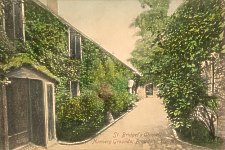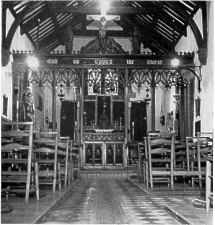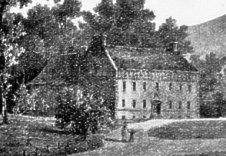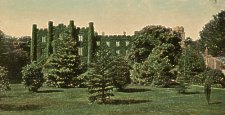 The
Nunnery, Douglas
The
Nunnery, Douglas The
Nunnery, Douglas
The
Nunnery, DouglasThe history of the Nunnery is shrouded in mystery. A summary of an inquisition of 1414 written in 1515 describes it as Cistercian which makes the supposed dedication to St Brigid doubtful (Cistercian establishments, as for example Rushen Abbey, would be dedicated to St Mary). The Chronicle of Man records a visit by Robert Bruce in May 1313.
The Prioress was an important figure as a Baron in the Island. Like the other Manx monastic establishments it was suppressed by Henry VIII and was dissolved in 1540 when there were only three nuns and the Prioress Margaret Goodman. Easson gives reference for the grant of Douglas Priory to Thomas Hungate of the Royal household. The buildings were acquired by Richard Calcot the Lord's Controller who is supposed to have married the ex Prioress (which Dempsey strongly argues against). Their descendants, the Heywoods occupied a house on the site before selling it to the Taubmans in 1776.
Blundell writing in 1648 states:
There is a house wherein a gentleman of an ancient family of the Calcots lives, which corruptly is called the Nunnery, but was indeed yt place which divers writers mention and call it the Priory of Douglas.
A view of the nunnery as it was in 1650's is shown by King
very little of the original establishment would appear to have survived
Waldron (c.1720) gives the following description
As to any buildings of great antiquity in this Island, there are now no remains, after Castle Russin and Peel Castle, with the churches about it, but the Nunnery and the Fort at Duglas, each of which I shall describe in a particular manner.That which is called the Nunnery, is situate in a good pleasant part of the country, about half a mile from Duglas; and the' now entirely out of repair, except one small part of it, where the present Major has his residence, shows in its ruins,-that few monasteries once exceeded it either in largeness or fine building. There are still some of the cloysters remaining, the ceilings of which discover they were the work of the most masterly hands, nothing in the whole creation but what is imitated in curious carvings on it. The pillars supporting the arches are so thick, as if that edifice was erected with a design to baffle the efforts of time; nor could it, in more years than have elapsed since the coming of Christ, have been so greatly defaced, had it received no injury but from time: but in some of the dreadful revolutions this Island has sustained, it doubtless has suffered much from the outrage of the soldiers, as may be gather'd by the niches yet standing in the chapel (which has been one of the finest in the world) and the images of the saints reposited in them being torn out, which could not have happened but by force.
Here has also been many curious monuments, the inscriptions of which, tho' almost worn out, yet still retain enough to make the reader know the bodies~of very great persons have been deposited here. There is plainly to be read on one of them,
Illustrissima Matilda filia * * * * *
and a little lower, on the same stone,
* * * * Rex Merciae * * * *
I think there is great probability that this was Matilda, the daughter of Ethelbert, one of the kings of England, of the Saxon race, since both Stow and Hollingshed agree that princess died a recluse: but as there is no certainty, the date being .; entirely erased, I shall leave it to my reader to think of it, according to his pleasure.
But I am entirely of opinion that Cartesmunda, the fair nun of Winchester, who fled from the violence threatened her by king John, took refuge in this monastery,*( i. e. Nunnery) and was here buried; because there is very plainly to be read, -. .
Cartesmunda Virgo immacu1ata.
These words remain so legible, that I doubt not but the whole inscription would have been so too, had not some barbarous and sacrilegious hands broke the stone, leaving only one corner of it, which is supported by a column, and on the base the date is yet perfectly fresh.
Anno Domini 1230.
Several fine figures, which seem designed by way of hiero glyphics, have also been both the ornaments and explanation of these tombs; but now so demolished, that one can only know by the fragments they have been too excellent not to have merited a better fate.
In the midst of a small square court behind this chapel is a sort of a pyramid of reddish stones cemented with clay, on which formerly stood a cross; and near it have been many fine monuments, tho' not so magnificent as those within the chapel.
 |
St Bridget’s Chapel is now the only existing remains of the original establishment, probably dating from the 12th or 13th c. Kermode quotes "Gothic doorway in the S. wall and two side-windows. Piscina of grey sandstone. Two pilasters from the cloister. Burial Ground adjoining". |
| The chapel, for long the stables, was reopened for worship in the late 19th C see Mx.Note Book iii, pp. 92/3 ; until 1998 it was still regularly served by St Matthews but then the new owner stopped these Anglo-Catholic services and the chapel was deconsecrated and allowed to decline. The chapel has now been converted to provide teaching space etc for Centre for Manx Studies. |
 |
Robertson in his 1792 Tour (chapter 5) summarises the Manx tradition as well as indicating the 18th C attitudes towards Catholic monastic (and especially female) establishments.
AT a little distance from Douglas is situated, in a most delightful solitude, the Nunnery. Close by the modern building is a venerable relique of the ancient priory; which, according to the Manks' tradition, was founded in the sixth century, by Saint Bridget, when she came to receive the veil of virginity from St. Maughold. From the pious celebrity of its foundress, the monastery was soon tenanted by female votaries; some of whom were compelled by parental ambition, while others were deluded by visionary joys, to frustrate the benignity of Nature, by sacrificing their youth and beauty at the shrine of Superstition. Yet, amid the gloom of this once-hallowed spot, Devotion might sometimes heighten the raptures of the enthusiast; or Religion, with her heavenly balm, heal the wounds of the unfortunate.The Prioress of Douglas was anciently a Baroness of the Isle. Her person was sacred; her authority dignified; her revenue extensive; and her privileges important. She held Courts in her own name; and from the Lord's Court she frequently demanded her vassals, and tried them by a jury of her own tenants. When such was her temporal authority, it may be presumed of her spiritual jurisdiction, that
" Here perchance a Tyrant-Abbess reign'd,
" Who rul'd the Cloister with an iron-rod *.,'But every vestige of her magnificence and dignity has long since vanished, except the ruins of the convent where she once presided: and even these, when a few years have glided away, will also disappear. Every ornament of its former grandeur is now levelled with the ground; the mouldering walls are mantled with ivy; cluttering wildflowers crown their summit; and the whole ruin, being shaded with aged trees, is at once gloomy and romantic.
The modern building has an air of elegance superior to any other in the Island. The gardens are spacious and luxuriant; and the surrounding fields, being highly cultivated, and finely interspersed with woods and waters, present an exquisite landscape. In this charming retirement, once consecrated to piety, but now sacred to hospitality, Captain Taubman, the worthy proprietor, enjoys " Otium cum dignitate;" not more esteemed by strangers, for his politeness and generosity, than respected by the natives, for his worth and benevolence.

Mrs Bullock writing in 1816 was less complementary of the buildings:
FROM Douglas to Castletown, which is the regular route, the distance is ten miles, the route: lies past the seat of Major Taubman, called. the Nunnery, from the ancient structure former occupying the same site; but of which not a vestige remains, except a gateway still supporting the old bell, but now forming an entrance to the stables. The gardens and grounds have some beautiful features, for many years the whole has been without a rival, and travellers finding nothing else to admire, have lavished. more praise than it deserves on this spot, which certainly has many advantages in point of situation, but the scenery is disfigured by the erection of small houses, a mill, a warehouse, and even by two bleachfields, evermore spread with linens of different shades, all which are directly in front of the mansion. The house is not more than a decent country seat, whose whitened walls are curiously finished by a cornice and bordering of deep red stone.
John Welch writing in 1836 was typically caustic
We now come to the site of the ancient Nunnery, with a fine modern castellated mansion built upon it, the seat of General Goldie, Speaker of the House of Keys. The turrets, however, are not completed, they want their battlements; at present they have no further finished appearance than a man without his head. Not a vestige of the once celebrated asylum for old maids and discontented virgins now remains. These receptacles, in the march of intellect and (no doubt) true chastity and piety, are becoming exceedingly unfashionable in all countries; the monastic brotherhood, even in bigoted Spain, strewing a disposition and evident determination to resist the denunciations and thunders of the Vatican, and have a turn-out or strike for wives. It is to be hoped the holy sisterhood will not be backward in following so good an example, or what will these honest men do for sweethearts ?
The followings views, the first by Ashe of 1833 and the second from Five Lithographs in the Isle of Man of c.1845 show the castellated nunnery in the background. The house was designed by Bath architect, John Pinch, jnr (the Goldie family lived in Bath for some of the year) and was extended several times later in the century.
|
|
|
|
Ashe, 1833 |
c.1845 |
|
The 1850's view shows the house and the 35ft high obelisk, a memorial to Thomas Leigh Goldie, Lt Colonel of 57th regiment and who fell in the Battle of Inkerman (Crimea) 5 Nov 1854. |
By the end of the century the house had become covered in ivy:

John Welch continues:
|
The Nunnery is distant from Douglas about half a mile, and nobly situated in an extensive park, hedged in by fine and extensive woods, to which the public have access, deriving a right to a road through the estate from some prescriptive tenure, which its present proprietor has in vain attempted to supersede, and this constitutes one of the chief public luxuries in the beautiful walks, always open and at hand. Among these shady groves and lengthened solitudes, an altar might very judiciously be raised, and dedicated to " the laughter-loving Queen;" for most of the marriages of the middle and lower classes of the town are here made up, though latterly the pleasure grounds of Castle Mona have in this respect vied with those of the Nunnery. And if we might not be accused of sacrilege in penetrating further into Love's Sanctuary, the stranger might readily conceive the "billing and cooing" that must therefore necessarily be constantly going on here in the pairing season, out of a population of 8,000; an occupation, indeed, which must very much perplex the spirits of those departed sisters who once otherwise employed their hours within these sacred precincts. |
Victorian Postcard of Nunnery Grounds |
The family generally associated with the Nunnery in the 19th century are the Goldie-Taubmans. Jenkinson, in his 1874 guide, sums up the numerous name changes:
It is the residence of the proprietor, Major John Senhouse Goldie Taubman, Speaker of the House of Keys. Goldie is the original family name. The Taubmans are an old Manx family, originally settled near Castletown. The Goldies are a very old Scotch family, and formerly had large possessions in Dumfriesshire, Kircudbrightshire, &c. About 1803, General Alexander John (then Colonel) Goldie, second son of General Thomas Goldie, of Goldie Lea, Dumfriesshire, married the daughter and heiress of Major Taubman of the Nunnery. The eldest son, John Taubman Goldie, a Lieutenant-Colonel (Scots Fusilier Guards) assumed, by royal licence, the additional name of Taubman. He married Ellen, daughter of Humphrey Senhouse, Esq., of Netherhall, Cumberland, and their son John Senhouse Goldie Taubman is the present proprietor.
Several monuments to this family exist within the grounds.
D.E. Easson Medieval Religious Houses Scotland London: Longmans 1957
At Home in the Nunnery Manx Life Vol 1 #1 pp11/16 July 1971
|
|
||
|
Any comments, errors or omissions
gratefully received The
Editor |
||